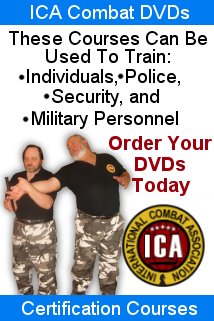|
 In Search Of A Grand Master
In Search Of A Grand Master
by Master Kevin May
A group of instructors were shocked to find out how much of the Art of
Tae Kwon Do was not being taught to them by their Master when they
went in search of a Grand Master.
|
 Tae Kwon Do: Setting The Example
Tae Kwon Do: Setting The Example
by Grand Master John McDowell
In today's society with its changing values, many young people often find themselves without guidance.
One Master suggests how to help avert the possibility of our young being mislead.
|
|
 Suk-Dal: Striving For Perfection
Suk-Dal: Striving For Perfection
by Grand Master James S. Benko
Tae Kwon Do training stresses reaching for perfection, not just in the dojang, but in everyday life.
Grand Master Benko shares a moment from the past.
|
 In Nae: Perseverance
In Nae: Perseverance
by Grand Master James S. Benko
When we hear of the
suffering others endure, our problems may not seem too great.
A touching look at how one woman persevered in the face
of countless hardships.
|
|  The Korean Ji Pang E (Cane)
The Korean Ji Pang E (Cane)
by Grand Master James S. Benko
This simple walking aid can turn into one of the most effective weapons ever to be used for self-defense.
Learn more about the history and techniques of this unique self-defense tool.
|
 Tae Kwon Do: The Metamorphosis
Tae Kwon Do: The Metamorphosis
by Sun Hee Kim
Learn how Tae Kwon Do changes a quiet and shy young man into a confident
Tae Kwon Do instructor others model themselves after. Follow him from first day in class to becoming a
Tae Kwon Do instructor and leader.
|
|
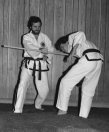 The Korean Jung Bong (Middle Staff)
The Korean Jung Bong (Middle Staff)
by Grand Master James S. Benko
The Jung Bong (Middle Staff) was used in several
different ways throughout Korean history. The illusive maneuvers of
the Jung Bong's defenses may be applied to all types
of martial arts training.
|
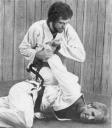 Kwan Jyel Sul (Joint Manipulation)
Kwan Jyel Sul (Joint Manipulation)
by Grand Master James S. Benko
Kwan jyel sul can be found in many forms of the martial arts; chin-na, aikido, karate, jujitsu, judo, ninjitsu,
TaeKwon-Do, hapkido, hwa rang do, yudo, kuk sool won, yu sool, and many other styles.
|
|
 Coming From Australia To Train With
Coming From Australia To Train With
Grand Master Benko
by Master Michael Wallace
I and three of my school instructors travelled from Australia to the ITA World Training Headquarters
to train with and test directly under ITA president and founder, Grand Master James S. Benko.
|
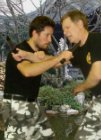 ICA Practical Combat Training Tactics
ICA Practical Combat Training Tactics
by Master Jerry Neale
The ICA (International Combat Association) offers combat training programs.
Grand Master Benko, founder of the ICA, developed these combat training programs
in order to help prepare individuals and groups for combat.
|
|
 Theories Of Defensive Action
Theories Of Defensive Action
by Grand Master James S. Benko
There are eight primary directions from which an opponent could attack you and permit him to enter your defensive area.
These eight directions are referred to as the eight AVENUES OF APPROACH. The angles of evasion correspond with the eight
avenues of approach.
|
 Mu Ki Pang Wi
Mu Ki Pang Wi
(Self-Defense Against Weapons)
by Grand Master James S. Benko
If when confronted by an opponent who has a weapon, you are unable to reason with him or walk
away peaceably, then you must be prepared to defend yourself or face the consequences.
|
|
 Tahn Bong (Short Stick)
Tahn Bong (Short Stick)
by Grand Master James S. Benko
There are many types of traditional martial arts weapons, one of the most practical
weapons of self-defense is the Tahn Bong (short stick). It can be found anywhere.
It may be a pencil, a ruler, or a piece of stick. The Tahn Bong may be easily adapted to almost
any self-defense situation.
|
 Wa Ki Sul
Wa Ki Sul
(Ground Fighting)
by Grand Master James S. Benko
Most martial arts practitioners are taught how to throw someone. They are also taught how to roll
and breakfall to help avoid being injured during practice. But few are taught how to defend themselves
once they have been thrown to the ground.
|
|
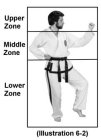 Zones of Defense (Pang Wi Chi Dae)
Zones of Defense (Pang Wi Chi Dae)
by Grand Master James S. Benko
The "Zones" are used in every form of martial arts. The zones of defense are divided into three categories; height zones, width zones, and depth zones.
These zones, are used when performing either defensive or offensive techniques.
|
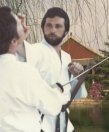 The Korean Cha-Ru (Tonfa)
The Korean Cha-Ru (Tonfa)
by Grand Master James S. Benko
Learn the Historical Background of the Korean Cha-Ru, its Strikes, Blocks, Trapping Techniques,
Disarms, Multiple Range Capabilities, and Variable Height Possibilities. View the Chart showing the
Anatomy of the Cha-Ru.
|


